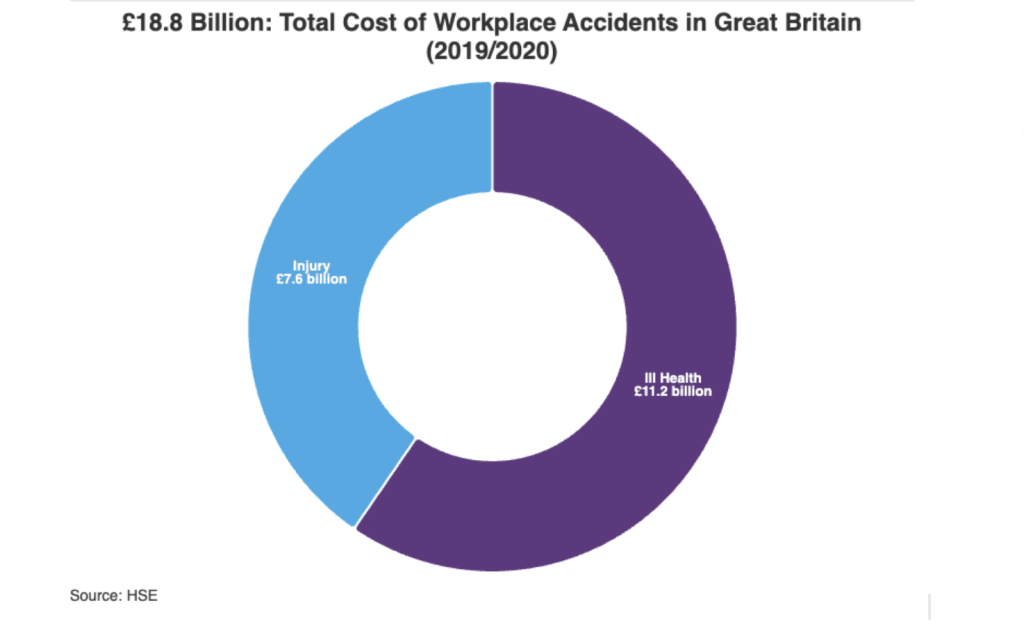Workplace accidents and injuries are an unfortunate yet regular occurrence in Great Britain. According to the Health and Safety Executive (HSE), over 600,000 workers sustained non-fatal injuries at work from 2018/2019 to 2021/2022. Another 619,000 workers suffered a bout of ill health related to or exacerbated by their work.
Aside from being devastating to employees’ health and well-being, these incidents impose a significant financial burden on businesses. HSE estimates show that work-related injuries and ill health cost the economy approximately £18.8 billion in 2019/2020.

Source: HSE
Understanding the true cost of workplace accidents and injuries is crucial to grasping the importance of a robust, preventive safety culture.
The Two Types of Costs Related to Workplace Accidents and Injuries
1. Direct Costs of Workplace Accidents
Workplace accidents and injuries impact businesses in two main ways: direct and indirect costs. Direct costs are relatively easier to calculate and include items such as medical expenses, insurance payments, and legal fees.
2. Indirect Costs: A Hidden Burden
Indirect costs, however, are less apparent and can often exceed direct costs. These include lost productivity, costs related to hiring and training replacements, damage to the company’s reputation, lowered employee morale, and potential increases in insurance premiums.
Exploring Direct and Indirect Costs in Detail
Direct costs comprise medical expenses, insurance payments, and legal fees. Conversely, indirect costs encompass a range of disruptions from diminished productivity and increased recruitment costs to reputational damage and increased insurance premiums. Moreover, businesses can face fines for non-compliance with health and safety regulations, which can also contribute to the indirect costs of workplace accidents.
The Human Impact
Moreover, the indirect costs extend beyond financials. A pattern of accidents can instil fear and uncertainty among employees, leading to decreased morale, job satisfaction and employee engagement. These elements, though hard to quantify, contribute significantly to a company’s success.
Investing in Safety: A Sound Business Strategy
Workplace accidents and injuries present a significant cost burden to businesses, spanning both direct and indirect costs. The price tags attached to these incidents are far more than monetary and can severely impact a company’s productivity, reputation, and overall culture.
In other words, preventing workplace accidents is not only a moral or legal obligation but also a sound financial strategy. Investments in safety training, personal protective equipment, regular equipment maintenance and safety audits can significantly reduce the incidence of workplace injuries and the associated costs.
Consider a Health and Safety Assessment
A health and safety assessment can help organisations by identifying potential hazards, assessing risks, and formulating preventive measures. It not only ensures adherence to legal requirements and industry standards but also creates a safer and healthier work environment. By systematically examining all aspects of the work environment, these assessments offer a comprehensive understanding of areas that need improvement, thereby aiding in the development of precise action plans.
This, in turn, leads to reduced work-related illnesses and injuries, increased productivity, enhanced employee morale and decreased compensation claims. In essence, health and safety assessments are instrumental in fostering a culture of safety, thereby promoting overall organisational well-being and sustainability.



 Bitcoin
Bitcoin  Ethereum
Ethereum  Tether
Tether  XRP
XRP  Solana
Solana  USDC
USDC  TRON
TRON  Cardano
Cardano  Lido Staked Ether
Lido Staked Ether  Avalanche
Avalanche  Toncoin
Toncoin